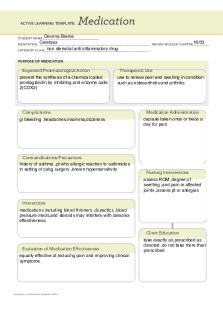Medication Template Insulin Lispro (Humalog) PDF

| Title | Medication Template Insulin Lispro (Humalog) |
|---|---|
| Course | NR 324 ADULT HEALTH |
| Institution | Chamberlain University |
| Pages | 1 |
| File Size | 63.6 KB |
| File Type | |
| Total Downloads | 93 |
| Total Views | 142 |
Summary
Download Medication Template Insulin Lispro (Humalog) PDF
Description
ACTIVE LEARNING TEMPLATE:
Medication
STUDENT NAME _____________________________________
Insulin Lispro (Humalog) MEDICATION __________________________________________________________________________ REVIEW MODULE CHAPTER ___________ Pharm ch.39
pancreatics(Pharm)/antidiabetics(Therapeutic) CATEGORY CLASS ______________________________________________________________________ PURPOSE OF MEDICATION
Expected Pharmacological Action ● Promotes cellular uptake of glucose (decreases glucose levels) ● Converts glucose into glycogen and promotes energy storage ● Moves potassium into cells (along with glucose)
Therapeutic Use Control of hyperglycemia in diabetic patients.
Complications ● Hypoglycemia ● Hypokalemia ● Lipohypertrophy
Contraindications/Precautions Contraindication: hypoglycemia; allergy or hypersensitivity to a particular type of insulin, preservatives, or other additives. Caution: stress and infection(may temporarily increased insulin requirements); renal/hepatic impariment(may decreased insulin requirements); Concomitant use with pioglitazone or rosiglitazone (increased risk of fluid retention and worsening HF; OB: pregnancy may temporarily increased insulin requirements.
Interactions ● Sulfonylureas, meglitinides, beta blockers, and alcohol have additive hypoglycemic effects with concurrent use. ● Concurrent use of thiazide diuretics and glucocorticoids can raise blood glucose levels and thereby counteract the effects of insulin. ● Beta blockers can mask SNS response to hypoglycemia(tachycardia, tremors), making it difficult for clients to identify hypoglycemia. Beta blockers also impair the body's natural ability to breakdown glycogen stores to raise blood glucose levels.
Evaluation of Medication Effectiveness Control of blood glucose levels in diabetic patients without the appearance of hypoglycemic or hyperglycemic episodes.
ACTIVE LEARNING TEMPLATES
Medication Administration Dose depends on blood glucose, response, and many other factors. Subcut ● Total insulin dose determined by needs of patient; generally 0.5~1 unit/kg/day;50~70% of dose may be given as meal-related boluses of rapid-acting insulin, and the remainde as an intermediate or long-acting insulin. ● Assess patient for signs and symptoms of hypoglycemia and hyperglycemia periodically during therapy ● Monitor body weight periodically. changes in weight may necessitate changes in insulin dose. ● LAB: blood glucose Q6hr, Hemoglobin A1c every 3~6 month to determine effctiveness, potassium ● Toxicity and overdose: overdose - hypoglycemia
Nursing Interventions • Because of the high error rate, 2 nurses must check the insulin type and dose. • Very rapid-acting agents are called “dose and eat” for a reason. Onset 5–15 min(very rapid acting) • Memorize the peak time of these medications; Look for hypoglycemia (normal 70–120 mg/dL). • Hypoglycemia looks like an anxiety attack with cold, clammy skin.
Client Education • Use U-100 syringes with solutions containing 100 units/mL. • Sick days require more monitoring. • Carry a source of glucose. • Wear a Medic-Alert bracelet. • Watch for signs and symptoms of hypoglycemia and hyperglycemia, and know what to do if they occur....
Similar Free PDFs

Insulin lispro - Med card
- 1 Pages

Fast Acting Insulin Medication
- 1 Pages

ATI Warfarin Medication Template
- 1 Pages

Captopril medication template
- 1 Pages
Popular Institutions
- Tinajero National High School - Annex
- Politeknik Caltex Riau
- Yokohama City University
- SGT University
- University of Al-Qadisiyah
- Divine Word College of Vigan
- Techniek College Rotterdam
- Universidade de Santiago
- Universiti Teknologi MARA Cawangan Johor Kampus Pasir Gudang
- Poltekkes Kemenkes Yogyakarta
- Baguio City National High School
- Colegio san marcos
- preparatoria uno
- Centro de Bachillerato Tecnológico Industrial y de Servicios No. 107
- Dalian Maritime University
- Quang Trung Secondary School
- Colegio Tecnológico en Informática
- Corporación Regional de Educación Superior
- Grupo CEDVA
- Dar Al Uloom University
- Centro de Estudios Preuniversitarios de la Universidad Nacional de Ingeniería
- 上智大学
- Aakash International School, Nuna Majara
- San Felipe Neri Catholic School
- Kang Chiao International School - New Taipei City
- Misamis Occidental National High School
- Institución Educativa Escuela Normal Juan Ladrilleros
- Kolehiyo ng Pantukan
- Batanes State College
- Instituto Continental
- Sekolah Menengah Kejuruan Kesehatan Kaltara (Tarakan)
- Colegio de La Inmaculada Concepcion - Cebu











